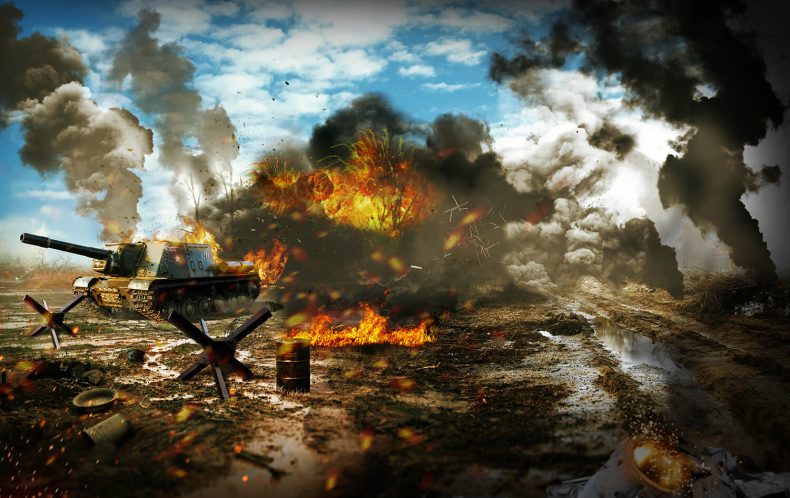Optimizing seat safety within the space limitations of a tank turret
Blog

The Need for Advanced Blast Protection Systems
Whether it’s new, more powerful types of artillery blast or the rise of improvised explosive devices (IEDs) on the battlefield, troops face ever-increasing risks. The injuries resulting from such attacks can be devastating. Researchers analyzing official data on close to 30,000 United States military casualties from 2003 to 2014 found that approximately half of injuries to US service members deployed to Iraq and Afghanistan were caused by explosives. By comparison, only 15 percent were the result of gunshot wounds.
Explosions may result in unique patterns of injury that are rarely seen outside combat situations. Depending on the type of explosive and the proximity of the victim to the explosion, injuries can differ greatly. Primary injuries from the blast wave can cause abdominal hemorrhage and perforation, concussions, and the rupturing of other body parts. Secondary injuries from flying debris and bomb fragments might also penetrate or cause blunt trauma, while tertiary injuries like fractures or severe burns can result from effects like the so-called blast wind, the superheated flow of air caused by an explosion.
There are various ways that soldiers can be protected from such attacks, such as protective gear like body armor, vehicle armoring, and energy-absorbing blast protection systems for military vehicles.
Individual troop body armor can range from lighter flak jackets, which protect the wearer’s from case fragments from high explosive weapons to full protective bomb suits, designed to cover the wearer’s entire body and shield it from the explosive pressure and fragments generated by a bomb.
Similarly, there are different approaches to protecting military vehicles on the battlefield. Armored vehicles are main battle tanks, armored cars, armored personnel carriers, and more. These vehicles have a tough outer shell which protects them from attack similar to the body armor described above, only capable of protecting an entire vehicle and its occupants.
Increasingly popular are energy-absorbing systems for military vehicles. They are a game-changer when it comes to the evolution of military vehicles because it allows vehicles to absorb kinetic energy from blasts without slowing down or becoming unwieldy. Naturally, energy-absorbing systems have accompanied the rise of IEDs on the battlefield.
MOBIUS PS’s blast absorbing seats are a highly sophisticated example of an energy-absorbing system for a military vehicle. The company’s seating solutions, designed especially for use in military vehicles, protect troops travelling inside vehicles without having to carry out significant changes to the internal layout of these vehicular platforms. They are versatile solutions that have been designed from the ground up to fit a range of troop types and roles.
MOBIUS PS seating solutions use very own patented SPIRAL technology to provide incredibly powerful and impressively energy-absorbing element to mitigate the high energy levels of an explosive event. The ergonomic seats protect crew members by isolating them from the body of the vehicle they are travelling in. Should an underbelly explosion occur as the result of a military vehicle driving over an IED or other ground-based explosive, the seating system will absorb and attenuate the blast force even as the shockwaves travel through the rigid body of the combat vehicles.
Our blast-protecting seats score outstandingly well in tests. The Dynamic Response Index (DRI) is reduced to under 17.7: an outstandingly low score. DRI refers to the measure of the likelihood that spinal damage will occur as the result of a vertical shock load like an underbody mine blast. It scores well even when the seats have been subject to multi-hit attacks, meaning that this is no “one and done” solution. The seats will carry on working as well as ever even after lengthy periods of active service.
It is the flexibility of our advanced blast protection systems that makes them particularly valuable. They have also been engineered to offer blast-attenuating support to a range of different crew positions, including gunner, driver, crew, and troop seats.
Each seat has been created with full knowledge of what is required of those troop roles, so that the seats’ inhabitant can perform his or her job while being safeguarded. Our seats weigh between 17 and 22 kg, and can be mounted on the wall, floor, or even the ceiling of a vehicle. They have been especially developed to fit everyone from the most lightweight 5th percentile female to a heavyset 95th percentile male. Given our impressive track record, it’s no wonder that more than 13,000 units of these seats have been deployed on 45+ vehicular platforms in 26 countries.
Blast-protecting seats are, of course, only one part of fully integrated, advanced blast protection systems needed for a modern military vehicle. Other technologies include defensive systems such as IED jammers, which block the radio signals used to trigger IEDs, or new types of armoring that take advantage of breakthroughs in materials science. Some vehicles like the Mine-Resistant Ambush Protected (MRAP) light vehicle will also employ innovative design touches like a V-shaped hull and special angled sides so as to be able to better deflect rocket-propelled grenades (RPGs).
The threats that modern troops face are only getting worse. Fortunately, the advanced blast protection systems that can help those same troops are getting more sophisticated as well. If you are in charge of designing seat solutions for military vehicles, you’ll be well aware of the importance of protecting troops who willingly put their wellbeing on the line. Blast-protected seats can perform an essential job in keeping them safe and minimizing the risk of injury or worse.
If you have any queries, get in touch with us at MOBIUS. We have a team of experts on hand who are ready to provide you answers to any questions you might have.